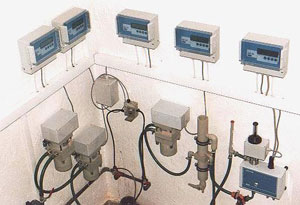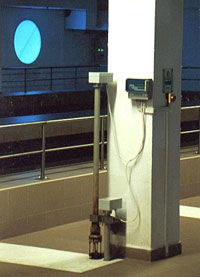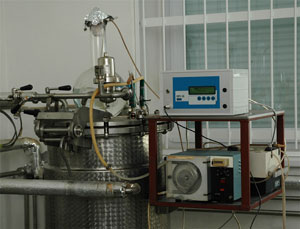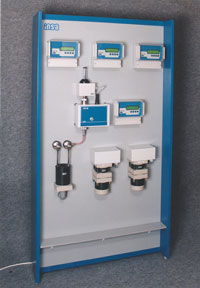Application examples
Do you have a problem with cleaning the pH electrode during basification or neutralisation by means of lime milk? Do you have to clean the pH electrode all the time? Or do you have a system based on acid spraying and you are unhappy with the constant re-filling of the acid and with the fact that the electrode measures useless values after the spraying?
If you have the above-mentioned problems, why not try an automatic cleaning system built into the probes of the SPO 1ME and SPR 41ME types?
Measuring of a pH value during water neutralisation by means of lime milk.
State of a sensor after a four-month operation without manual cleaning.
In these cases, INSA offers you an automatic mechanical cleaning of sensors. This system has proved to be very efficient and easy to use during its operation, and more suitable than other cleaning systems. This system, verified by tens of applications, works reliably even during low temperatures and in chemically and biologically polluted water. The system is simple and reliable, and there is no need of applying additional chemical agents. The system works reliably during the feeding of lime milk or during the measuring of pH of water containing aggressive ferrum.
Drinking water treatment plants  The pH factor is the basic physico-chemical parameter monitored in the course of drinking water production.
The pH factor is the basic physico-chemical parameter monitored in the course of drinking water production.
If the untreated water entering the water treatment process is surface water, whose properties change significantly in relation to a whole range of factors, it is especially necessary to know the pH factor of the raw (untreated) water. If the measurement is to be reliable, accurate and not requiring frequent and regular attendance, it is necessary to use sensors with automatic cleaning.
Controlling pH factor is of absolute necessity during the removal of ferrite and manganese by means of alkalisation. However, continuous measuring is very difficult, especially at high manganese concentrations. Application of sensors with automatic cleaning of the SPO 41MEK and SPR 41ME types appears to be a necessity in this case. Thanks to automatic cleaning and quality pH electrodes, the INSA instruments manage to work without attendance and with the required accuracy (pH 0.1) for minimally one month – even if there are extremely high concentrations of manganese. At the same time, it is possible to utilise an in-built controller capable of maintaining the pH factor even in cases when the regulation process is very difficult - for example, during controlling a screw feeder of lime hydrate.
 An optimal pH factor is to be maintained for controlling coagulating and flocculating processes as well. Due to the fact that water, after flocculating agents are dosed, contains a number of floccules that settle on the surface of a pH electrode, it is suitable to undertake measuring by means of sensors with automatic cleaning.
An optimal pH factor is to be maintained for controlling coagulating and flocculating processes as well. Due to the fact that water, after flocculating agents are dosed, contains a number of floccules that settle on the surface of a pH electrode, it is suitable to undertake measuring by means of sensors with automatic cleaning.
In most water treatment plants, the pH factor is adjusted to the desired level by adding lime milk during a water-treatment process. Continuous measurement of the pH factor is a necessity for effective control of the lime milk dose. Nevertheless, in most cases, measuring the pH factor is almost impossible without effective automatic cleaning.
As the pH value determines the effect of water on water distribution systems (corrosion and incrustation), it is also important to measure the pH factor of the treated water at the outlet of a water treatment plant.
Biological wastewater treatment plants
As the optimal running of biological processes goes only in a very limited range of pH values, the measuring of the pH factor at the input of a wastewater treatment plant is very important, especially where it is not possible to rule out the occurrence of extreme pH values, which can completely destroy the whole purifying process. The measuring process of pH values at the input of a wastewater treatment plant is relatively difficult due to the fact that the water may contain a large amount of grease and, where there are not quality screens (racks), also various fibre substances. If the screens do not let the fibres through, the SPO 41MEK sensor with automatic cleaning is the optimal solution. If it is not the case, the SPO 41K sensor should be used - with a spherical cover protecting it against damage and fibre substances, and ensuring optimal water flow around the sensor.
Neutralising and coagulating processes If neutralisation is carried out by means of lime milk, sensors are in most cases rapidly clogged with lime incrusts causing distortion of the measured values. In addition, the pH value may deviate from the actual value by one pH unit in the course of 24 hours. To ensure proper measurement, the sensor has to be laboriously cleaned several times a day.
If neutralisation is carried out by means of lime milk, sensors are in most cases rapidly clogged with lime incrusts causing distortion of the measured values. In addition, the pH value may deviate from the actual value by one pH unit in the course of 24 hours. To ensure proper measurement, the sensor has to be laboriously cleaned several times a day.
However, the utilisation of a sensor with automatic cleaning of the SPO 41MEK or SPR 41ME types is an unrivalled solution for the above-mentioned cases, verified in tens of different applications and enabling long-term and reliable no-service operation of the particular equipment.
Controlling fermentation processes
It is necessary to guarantee an optimal value of the pH factor in order to ensure the optimal course of a fermentation process and maximal fermentation efficiency. The continuous controller of a pH transducer reliably manages to control proportioning pumps in a way that the pH value is always optimal. For these applications, it is possible to utilise a two-channel version with two controllers for simultaneous control of two fermenters.
 For these applications, the transducer for measuring pH values is provided with an external calibration mode, which facilitates calibration procedures.
For these applications, the transducer for measuring pH values is provided with an external calibration mode, which facilitates calibration procedures.
Fish farming
The pH value is a significant factor for fish farming. Especially salmonid fish is very sensitive to pH. Surpassing the critical pH level results in fish dying-off and huge economic loses.
The principal problem during pH measurement, especially where there is a huge density of fish (at fish storage ponds), is the contamination of the surface of pH sensors. We recommend that sensors of the SPO 41MEK or SPR 41ME types with automatic cleaning should be used.
Indoor and open-air swimming pools
The optimal pH value is automatically kept by transducers for measuring pH value – by proportioning lye or acid. For these applications, it is convenient to use the MFD 88 - pH + chlorine controllers measuring pH and chlorine, or the MFD 88 - pH + ORP + chlorine controller measuring pH, chlorine and redox potential.
Surface water monitoring  Measuring the pH value is the principal parameter in the course of monitoring surface water. As surface water is more or less biologically activated, contamination of sensors is a pressing problem even in these cases. Biological accretion on a pH electrode results in changes of the pH value by up to 0.5 units. If daily cleaning is not possible or undesirable, automatic cleaning is the only solution. The maintenance of the pH measuring process is then limited to one-point calibration once in 4 - 6 weeks.
Measuring the pH value is the principal parameter in the course of monitoring surface water. As surface water is more or less biologically activated, contamination of sensors is a pressing problem even in these cases. Biological accretion on a pH electrode results in changes of the pH value by up to 0.5 units. If daily cleaning is not possible or undesirable, automatic cleaning is the only solution. The maintenance of the pH measuring process is then limited to one-point calibration once in 4 - 6 weeks.


